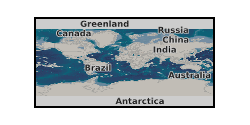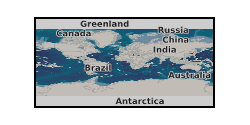Serpentinite
Type of resources
Available actions
Topics
Keywords
Contact for the resource
Provided by
Years
Formats
Update frequencies
-

The data include:- sample description file: sample full names, site, hole, depth etc., a quick petrographic description of the sample and the embedding serpentinite mud, and information regarding sample selection for bulk rock chemistry - microprobe analyses of selected samples - bulk rock major and trace elements from 2 labs (SARM, Nancy and VUB, Brussels) - Oxygen Isotopes of both pore fluids and rock samples with estimated temperature equilibrium
-

Cyclic loading stress-strain data in polycrystalline antigorite serpentinite, at various confining pressures and temperatures. This dataset is used and fully described/interpreted in the paper: David, E.C., N. Brantut, and G. Hirth, Sliding crack model for non-linearity and hysteresis in the triaxial stress-strain curve of rock, and application to antigorite deformation, submitted to J. Geophys. Res. Overview Rock type Vermont antigorite-rich (>95%) serpentinite. See submitted paper for details. The sample is isotropic. Apparatus Oil-medium triaxial apparatus (Rock Physics Ensemble, University College London). For description, see David el al. (2018), Absence of stress-induced anisotropy during brittle deformation in antigorite serpentinite, J. Geophys. Res., 123, 10616-10644. Griggs-type solid medium apparatus (Brown University). For description, see David, E.C., N. Brantut, and G. Hirth, Sliding crack model for non-linearity and hysteresis in the triaxial stress-strain curve of rock, and application to antigorite deformation, submitted to J. Geophys. Res., and references therein. Files description 1-existing data from David et al., JGR, 2018: The text file "Vermont-antigorite-roomT-150MPa-stress-strain-cyclicloading-UCLtriax" gives the axial stress (in direction 1, see submitted paper) and the axial strain (in percent, in direction 1, see submitted paper), at room temperature and 150 MPa confining pressure, in the oil triaxial apparatus at UCL. The mechanical data (stress, strain) have been corrected from internal friction and machine stiffness, respectively. The data are from David el al. (2018), Absence of stress-induced anisotropy during brittle deformation in antigorite serpentinite, J. Geophys. Res., 123, 10616-10644. 2-new data: The text file "Vermont-antigorite-roomT-1000MPa-stress-strain-cyclicloading-Griggsapparatus" gives the axial stress (in direction 1, see submitted paper) and the axial strain (in percent, in direction 1, see submitted paper), at room temperature and 1000 MPa confining pressure, in Griggs solid medium apparatus at Brown University. The mechanical data (stress, strain) have been corrected from internal friction and machine stiffness, respectively. The text file "Vermont-antigorite-400C-1000MPa-stress-strain-cyclicloading-Griggsapparatus" is the equivalent of the file described just above at a temperature of 400C. The text file "Vermont-antigorite-500C-1000MPa-stress-strain-cyclicloading-Griggsapparatus" is the equivalent of the file described just above at a temperature of 500C.
-

These data contain the shear modulus and attenuation of Vermont antigorite serpentinite in the seismic "low" frequency range, as functions of oscillation period (ranging from 1 to 1000s) and temperature during staged cooling from 550 degrees C down to room temperature, at a confining pressure of 200 MPa. This dataset is used and fully described/interpreted in the paper: David, E.C., N. Brantut, L.N. Hansen and I. Jackson, Low-frequency measurements of seismic velocity and attenuation in antigorite serpentinite, submitted to Geophys. Res. Lett.
 NERC Data Catalogue Service
NERC Data Catalogue Service